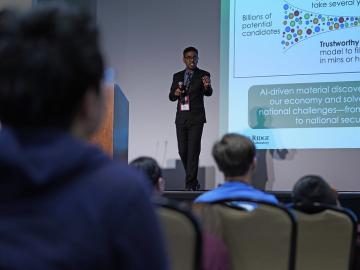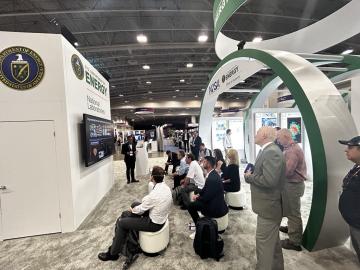
Filter News
Area of Research
- Biological Systems (1)
- Biology and Environment (43)
- Biology and Soft Matter (1)
- Clean Energy (42)
- Computational Biology (1)
- Electricity and Smart Grid (1)
- Fusion and Fission (20)
- Fusion Energy (4)
- Isotopes (6)
- Materials (21)
- Materials for Computing (1)
- National Security (17)
- Neutron Science (11)
- Nuclear Science and Technology (16)
- Supercomputing (42)
News Type
News Topics
- (-) Artificial Intelligence (48)
- (-) Biomedical (29)
- (-) Clean Water (14)
- (-) Decarbonization (46)
- (-) Grid (25)
- (-) High-Performance Computing (44)
- (-) Nuclear Energy (55)
- (-) Security (11)
- (-) Space Exploration (12)
- 3-D Printing/Advanced Manufacturing (41)
- Advanced Reactors (8)
- Big Data (26)
- Bioenergy (51)
- Biology (60)
- Biotechnology (11)
- Buildings (19)
- Chemical Sciences (25)
- Climate Change (50)
- Composites (8)
- Computer Science (86)
- Coronavirus (17)
- Critical Materials (3)
- Cybersecurity (14)
- Education (1)
- Emergency (2)
- Energy Storage (29)
- Environment (104)
- Exascale Computing (26)
- Fossil Energy (4)
- Frontier (24)
- Fusion (31)
- Hydropower (5)
- Isotopes (27)
- ITER (2)
- Machine Learning (22)
- Materials (43)
- Materials Science (45)
- Mathematics (7)
- Mercury (7)
- Microelectronics (2)
- Microscopy (20)
- Molten Salt (1)
- Nanotechnology (16)
- National Security (39)
- Net Zero (8)
- Neutron Science (47)
- Partnerships (18)
- Physics (29)
- Polymers (8)
- Quantum Computing (21)
- Quantum Science (30)
- Renewable Energy (1)
- Simulation (32)
- Software (1)
- Statistics (1)
- Summit (30)
- Sustainable Energy (47)
- Transformational Challenge Reactor (3)
- Transportation (27)
Media Contacts

Two ORNL teams recently completed Cohort 18 of Energy I-Corps, an immersive two-month training program where the scientists define their technology’s value propositions, conduct stakeholder discovery interviews and develop viable market pathways.

Power companies and electric grid developers turn to simulation tools as they attempt to understand how modern equipment will be affected by rapidly unfolding events in a complex grid.

Researchers at the Department of Energy’s Oak Ridge National Laboratory and partner institutions have launched a project to develop an innovative suite of tools that will employ machine learning algorithms for more effective cybersecurity analysis of the U.S. power grid.

Brian Sanders is focused on impactful, multidisciplinary science at Oak Ridge National Laboratory, developing solutions for everything from improved imaging of plant-microbe interactions that influence ecosystem health to advancing new treatments for cancer and viral infections.

In the wet, muddy places where America’s rivers and lands meet the sea, scientists from the Department of Energy’s Oak Ridge National Laboratory are unearthing clues to better understand how these vital landscapes are evolving under climate change.

SCALE users from 85 organizations across 21 countries gathered online and in person at Oak Ridge National Laboratory from June 5 to June 7 for the Eighth Annual SCALE Users Group Workshop. The meeting included 32 presentations and 14 hands-on tutorials on impactful and innovative applications of SCALE.

Andrew Conant from ORNL's nuclear nonproliferation division is collaborating with national laboratories to analyze isotopes generated in nuclear reactors. This research aims to glean insights into the operations and objectives of these reactors. ORNL, renowned for its leadership in nuclear research, maintains its legacy by promoting the peaceful utilization of nuclear energy worldwide.

Prasanna Balaprakash, a national leader in artificial intelligence, or AI, spoke to some of the highest achieving students in the country at the National Science Bowl in Washington D.C.

ORNL researchers and communications specialists took part in the inaugural AI Expo for National Competitiveness in Washington D.C, May 7 and 8, to showcase and provide insight into how the lab is leading the way for utilizing the vast possibilities of AI.

Building innovations from ORNL will be on display in Washington, D.C. on the National Mall June 7 to June 9, 2024, during the U.S. Department of Housing and Urban Development’s Innovation Housing Showcase. For the first time, ORNL’s real-time building evaluator was demonstrated outside of a laboratory setting and deployed for building construction.


